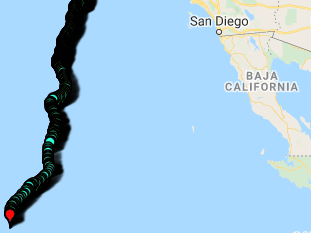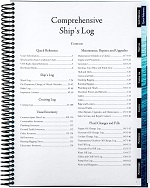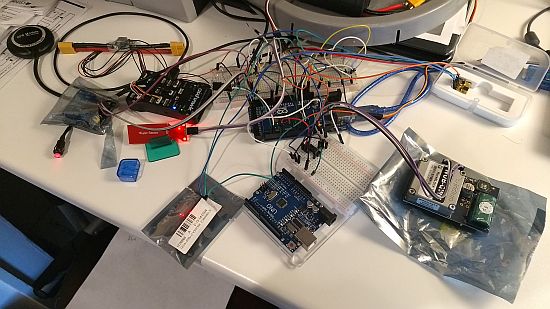From direct drive to magnetic coupling
The first 90 percent of the code accounts for the first 90 percent of the development time. The remaining 10 percent of the code accounts for the other 90 percent of the development time.
— Tom Cargill, Bell Labs
Yes, its been a long while since I last posted, but only because building this boat is taking forever 🙂 Although the quote above is about programming (which I’ve had completed with my last update), it echos my sentiment about the build process to a T. Every step takes days to complete from conceptualization to build. Many mini steps are required to finish one main step, but sometimes that main step needs another mini step on a different portion of the boat to be completed. Either way, its taken quite a bit of time to get me to where I am at currently, at 98% completion (what does that even mean!? haha).
Case in Point: The Magnetic coupling
One hurdle I ran into was swapping from a direct drive shaft sealed from external elements by 3 cup seals to a magnetic coupling sealed with two cup seals and a waterproof (I hope) barrier (I probably should have used 3 cup seals).
My original intent for LoCarb was to just go simple and seal the propeller drive shaft with three cup seals stuffed into a brass tube with some grease and bushings. I wouldn’t have to worry too much about any mechanical failure except the cup seals and instead would only worry about the water that would seep in. Being a brush-less motor, it would still function until rust and corrosion overcame the magnets and bearings.
But corrosion, rust…
Worry often gives a small thing a big shadow.
It started with me realizing cup seals aren’t really meant for rotary applications…They may fail prematurely.
Then it went to trying x-rings or quad ring o-rings (which btw are dirt cheap compared to cup seals). But then the high friction imposed by the better sealing properties disqualified them immediately. So out of o-ring options and knowing that my cup seals WILL fail, I needed to come up with a better solution.
3D print a magnetic coupling? Not ideal, but why not…
LoCARB is an exercise in the application of cost and utility. Can I design a magnetic coupling that is strong, waterproof, and compact enough to work with an autonomous boat? I sure could, but how much would that cost? Pricing out a few options, I realized that to have a magnetic coupling machined would be rather expensive. In the multitudes of $400-$1000 range. Having it made out of aluminum from an online service? About the same price.
“It would be worth it” I tried to tell myself, “it would be strong and work well.” But going back to the mission of the project I knew I couldn’t let myself spend that much money even if it meant the difference between success or failure in achieving my goal.
Could I build a coupling for cheap!?
Before I started this project I could not. But after working with this project for some time, I realized that I had gained enough of a skill set where I could potentially design and print one…I purchased a 3d printer since it was on sale a few months ago and began to use tinkercad.com to design objects (which btw is an extremely easy to use tool for getting into 3d printing). After a few months building basic things, I thought I might try to build a magnetic coupling with it.
Radial Magnetic Coupling
Initially, I began work on a disc shaped magnetic coupling with magnets situated on the face of the disc (radial magnetic coupling).

This was problematic for several reasons:
- The force exerted by the magnets facing each other was too great
- The rotational torque holding strength which would hold the two together pieces together in sync when torque was applied was too low given the pull strength (1)
- There was no easy/cheap solution in this application to lubricate or reduce the friction of thrust forces the pull between the two disc faces exerted (no appropriate off the shelf ceramic thrust bearings the design required).
Co-Axial Magnetic Coupling
This is when serious thought was given to designing a co-axial coupling as the benefits fit the application:
- Pull strength does not exert any real frictional pull force onto the shaft coupling (should somewhat cancel out if co-axially arranged magnets are properly aligned).
- High torque strength given the pull strength between couplings.
- Many options for regular rolling element bearings available in order to reduce friction between the parts
I really wanted a radial disc shaped coupling to work as it would be much easier to design, but in the end I had to go with the co-axial coupling design.

Here is my attempt:
It started with making end caps for the battery pod which will be submerged under water.
Inner portion solvent glued to outer portion
Done drying
Motor mount designed and 3D printed. This will be solvent glued to the exterior face of the end cap
Fits O.K.
Holes for motor mount bolts, wires, and temperature sensor complete
Looks like it aligns O.K.
You can see the direct drive shaft coupling still on the motor – this was before I decided to go magnetic coupling. In hindsight I needed this part to center the entire motor assembly around the shaft anyway.
Wires sealed with some flexible marine sealant. If the magnetic coupling works as intended this part should not be exposed to water anyway.
Repurposing a PVC toilet flange to hold the rest of the assembly works quite well. There is a lot of dry test-fitting in order to get the flange centered on the motor shaft spin axis. There is some play between all the loose parts of the assembly which allows for a decent degree of adjustment.
I needed to print a raised border ring which I cemented in position to allow me to pour the epoxy without it going all over the place. I inserted the flange bolts through the end cap and then poured the epoxy. I then lowered the toilet flange onto the bolts and tightened them down, creating a waterproof seal around the four through-hull bolt holes.
I treated both the PVC toilet flange and PVC end cap with sandpaper and flame abraded the surfaces to encourage epoxy adhesion. The internet told me it would work…buttttt I used the bolts just in case. I’ll put some flexible sealant around the exposed metal from the bolts later.
An exploded 3D model view of my magnetic coupling
Autonomous Boat Magnetic Coupling Prototype – Inner, outer, and waterproof barrier all seem to fit.
Before the magnets (alternating poles) are epoxied in, it’s nice to have extra magnets to hold them in place. They are 15 mm x 6.5 mm x 3 mm rectangular Neodymium fridge magnets.
The epoxied motor-side outer coupling – notice the inner retaining stop ring on the inner wall of the motor housing. This is where the PVC reducer on the inner coupling assembly will sit flush against for dry test-fitting and alignment (it is push-fit and can be adjusted with a little pressure).
A view of the waterproof barrier which acts as a bearing carrier for the inner magnetic prop shaft coupling
View of the inner prop shaft magnetic coupling within the water proof barrier.
The prop shaft fits into a brass tube with 2 cup seals and four bushings to hold them in place (two per seal). The housing is made up of pvc pipes, caps, and reducers. The spacers holding the brass tube center are 3d printed in ABS and cemented in place.
The waterproof barrier is cemented into place along its flange face with the PVC reducer.
Inner magnetic coupling with little nubbin (for lack of a better word) that fits into a standard roller bearing (like whats used in a skateboard). The bearing is a cheap ~$8 full ceramic bearing (which research shows actually increases the power required to use, but whatever… I need something to hold the part in place).
Aluminum flange coupling to aluminum prop shaft with aluminum screws. Epoxied and ready to go. The prop shaft is held in place by two grub screws (steel) that have been metal epoxy sealed so salt water should not effect them (not shown). The prop shaft has also been squared off where grub screw meets shaft and epoxied in place (also so the grub screw will be recessed in its hole).
This is the finished portion of the inner magnetic coupling before being inserted into the motor-side portion.
This is where the inner retaining stop ring comes into play. I had to run the motor and insert the inner portion to make sure it did not interfere with any moving bits. The stop ring provided adjustable positioning when dry fitting so when the full assembly was cemented in, it was quickly positioned accurately (cement sets quickly!). I then printed a thick retaining ring and cemented it into place (which you can see installed where the two pieces meet), to provide additional strength.
What I learned
My Ender 3 printer produces great prints with PLA, however when using ABS I ran into a lot of trouble. No matter my print settings, I could not get consistent print dimensions and strength. I ran it using an enclosure, upped the temperature, and even tried different filament. In the end it came down to trial and error in terms of printing a usable print which had the strength, measurements, and quality I wanted from the coupling. I needed to use ABS as it allowed me to attach the item to PVC, use epoxy with the magnets to bond with the ABS parts, and it also provides better temperature properties before it fails.
I realized that despite my designs being true, the prints still came out slightly warped which affected the tolerances my magnetic coupling needed. I had to thin down the waterproof barrier walls in order to allow for play with the interior magnetic portion and make the motor-side coupling slightly larger. As such, there is the slightest wobble of the prop shaft. I compensated for the forces put on the coupling by positioning the cup seals and bushings towards the first 1/3 from the tip of the prop shaft assembly so hopefully everything works out OK. I have an air gap distance of ~3mm (magnet face to magnet face), which provides adequate strength for turning the 5-6″ propeller I aim to use in water without slippage.
Concerns
I am very concerned about the long term durability of the coupling. I anticipate the water proof barrier which acts a bearing carrier to fail within a few days of use. The walls are about 1mm thick, but honestly, printing ABS that thin exhibited some layer separation when I was printing a rectangular enclosure for another part. I didn’t see it in this smaller circular part however, and the circular shape does lend itself to a slightly stronger part.
If the barrier does not fail, the nubbin the inner coupling portion uses to fit inside the ceramic bearing will likely fail. I’ve broken it off using some pliers to see how strong it was and it didn’t require too much force (this is at 80% infill). But then again, this is with a lever-arm type of force rather than a push/pull type of force which the inner coupling will experience.
Any of these situations will probably cause the motor to stall as the coupling will then stick to the side of the motor-side coupling, and the force of friction caused by everything out of alignment will be too great.
Edit 01/14/2020: A BIG OOPSIE!
I’ve since realized I’ve had a huge brain fart in designing my magnetic coupling. I had been so concentrated on the tolerances and method of the way the pieces fit together, I had completely forgotten about the thrust forces generated by the propeller pushing against the barrier (BIG OOPS!). Being that the waterproof barrier/bearing carrier walls are ~1mm thick, and given the way 3D prints are done (A layer deposited on top of another layer) its almost certain that the barrier will separate, crack, or rupture, given enough time.
Fortunately, assuming I would need to adjust something on the prop shaft at a point after I assembled the prop housing assembly (because we all make mistakes), I allowed about 1/8″ – 1/4″ of play between the inner brass tube end and the face of the orange prop shaft flange coupling. I’ve since placed two Acetal co-polymer washers (because of its slipperiness and durability properties) up against the Rulon bearing at the tip of the prop assembly and pulled the inner magnetic portion of the coupling slightly away from the waterproof barrier. This effectively shifts the thrust forces generated by the propeller onto the washers at the tip of the prop assembly and against the Rulon bearing instead of it against the waterproof barrier.
This solution is most definitely NOT ideal as the washers will create friction and wear, but hopefully it will work till the boat can get to Hawaii. FAT CHANCE! 🙂
Conclusion
I’m sad to admit it, but failure is likely.
I strongly suggest the waterproof barrier used in the magnetic coupling assembly be made of metal and secured in a manner fitting for the load if the coupling is to survive for any prolonged period of time. It is the one part that bears the brunt of the thrust forces the propeller generates for the entire boat!
Edit 03/01/2020: A second chance after magnet failure
After testing the boat out at the lake for a few days the magnetic coupling failed, but not in the way that I expected it. In fact, the waterproof barrier worked to keep the motor dry and had suffered no damage. Instead what failed was something I did not anticipate, the epoxy. Yeah, the epoxy. When I took apart the magnetic coupling, I noticed that the magnets had come loose from the epoxy from both the motor side and the prop shaft-side. While the motor side only had two semi loose magnets which were still attached to the assembly, 5 entire magnets from the prop shaft-side had completely dislodged and were rubbing against the waterproof barrier. Whats surprising is that the coupling STILL functioned, albeit with lots of drag created by the 5 loose magnets (so that’s reassuring).
Under closer examination, I found that the epoxy had become soft and rubbery. In some areas the epoxy completely failed and peeled off. Some deductive reasoning later, I realized that my mistake was not letting the epoxy fully cure before sealing the magnetic coupling with PVC/ABS cement. PVC/ABS cement contains acetone, a solvent which will soften epoxy if the epoxy is not fully cured. As the ABS/PVC solvent slowly dried out, it released acetone vapors into the fully sealed compartment areas of the magnetic coupling, which began to weaken the uncured epoxy to the point of failure.
Key Takeaways:
- The Magnetic coupling is robust and can still function after magnets have come loose
- Proper care must be taken in letting epoxy fully cure, and minimizing epoxy exposure to acetone vapor (do not rush assembly).
Edit 07/26/2020: A new Waterproof Barrier
I’ve since replaced the waterproof barrier for the magnetic coupling with a machined PVC type II part. Its strong, rigid, and should last the journey! See the details here.



























One thought on “From direct drive to magnetic coupling”